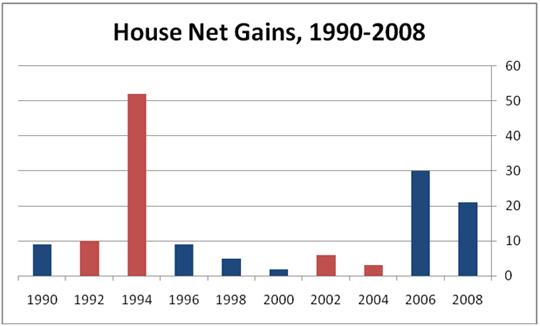Is the GOP On the Cusp of Another 1994?
A Commentary by Isaac T. Wood
All sound electoral predictions are grounded in history. Astute observers look back over the electoral landscape of the past and pick the bits and pieces of past years that match the conditions of the present. The upcoming House of Representatives elections in 2010 require the same approach. With that in mind, the Crystal Ball embarks on a short compare-and-contrast journey to examine the similarities and differences of the upcoming midterm and two of the most exciting elections of recent memory: 2006 and 1994.
2006
President George W. Bush's second midterm election will be remembered as the beginning of a four-year electoral hegemony for Democrats. Democrats picked up 30 seats and regained control of the House of Representatives, installing liberal Nancy Pelosi as Speaker. Republicans in 2010 are hungry to put a quick end to the era and turn this upcoming election into their own version of 2006. They are likely to be disappointed. First of all, Republicans must capture 40 seats to control the House, a gain that is outside the realm of reasonable probabilities, at least as this is written in September 2009. Forty is a high bar to clear, and even in the remarkably friendly year of 2006, Democrats gained just 30 seats.
Second, in that year, the Democrats made their gains without losing a single Democratic-held district. In 2010, Republicans are almost certain to lose a seat or two, and maybe more, with some seats extremely vulnerable: Louisiana's 2nd District (where Joseph Cao sits in a 75 percent African-American, heavily Democratic seat as a result of ex-Democratic Congressman Bill Jefferson's corruption scandal), open seat contests in Illinois's 10th and Pennsylvania's 6th (where Republican incumbents Mark Kirk and Jim Gerlach are leaving the House to pursue higher office), and the possible open seat in Delaware (with the GOP Congressman Mike Castle weighing a Senate race, or retirement, among his options).
Perhaps the greatest similarity between the two years will be the number of seats gained by the minority party. The Crystal Ball's projections for 2010 suggest that Republicans will pick up a number of seats somewhere between the 21 Democrats gained in 2008 and the 30 they flipped in 2006.
1994
Another model for a wave election is 1994, when Republicans netted 52 House seats. This model immediately seems relevant, as it was a Democratic president's first midterm and, coincidentally, Democrats held 258 seats that year, just one more than Democrats do now. But, once again, that model is unlikely to foretell the 2010 story. Democrats will not surrender as many open seats as in 1994, when they lost 22 contests in which they had no incumbent candidate. At least as important is the disorganization and uncoordinated state of the GOP. Can anyone truly imagine the Republican Party successfully introducing, coordinating, and adhering to a "Contract With America"-style platform in 2010? Finally, there is the tarnished GOP brand which could give many voters pause. The Republican party which has been unpopular for the last five years, and even though Democrats have lost support in the current Congress, the GOP's favorability ratings remain flat and quite low.
Still, congressional approval rates are at subterranean levels that have not been witnessed since 1994, a severe threat to the majority party. With healthcare reform once again in the public eye, the comparison seems even more apt. In the end, 2010 ought to produce more gains for congressional Republicans than any year since 1994, but the '94 record for Republican gains will likely go unchallenged.
The above chart details how many net seats were picked up by either Democrats (in blue) or Republicans (in red) in each of the last ten House elections.
Isaac T. Woods is the House Race Editor for Sabato's Crystal Ball at the University of Virginia.
See Other Political Commentary
Rasmussen Reports is a media company specializing in the collection, publication and distribution of public opinion information.
We conduct public opinion polls on a variety of topics to inform our audience on events in the news and other topics of interest. To ensure editorial control and independence, we pay for the polls ourselves and generate revenue through the sale of subscriptions, sponsorships, and advertising. Nightly polling on politics, business and lifestyle topics provides the content to update the Rasmussen Reports web site many times each day. If it's in the news, it's in our polls. Additionally, the data drives a daily update newsletter and various media outlets across the country.
Some information, including the Rasmussen Reports daily Presidential Tracking Poll and commentaries are available for free to the general public. Subscriptions are available for $4.95 a month or 34.95 a year that provide subscribers with exclusive access to more than 20 stories per week on upcoming elections, consumer confidence, and issues that affect us all. For those who are really into the numbers, Platinum Members can review demographic crosstabs and a full history of our data.
To learn more about our methodology, click here.

